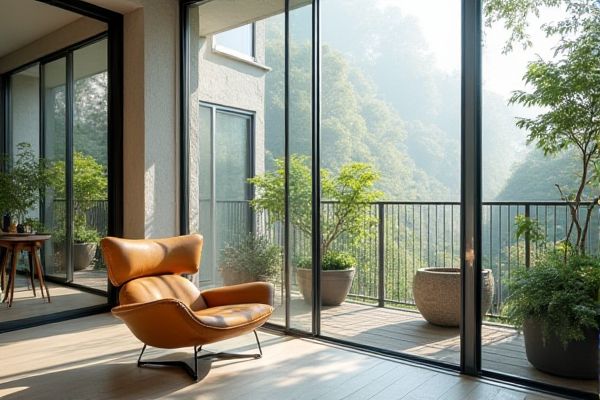
Transparent balcony covers allow maximum natural light to brighten your outdoor space while providing protection from the elements, creating an open and airy ambiance. Opaque balcony covers offer enhanced privacy and shade, ideal for reducing glare and heat; explore our detailed comparison to determine which option best suits Your balcony needs.
Table of Comparison
| Feature | Transparent Balcony Cover | Opaque Balcony Cover |
|---|---|---|
| Material | Tempered glass, acrylic | Polycarbonate, metal sheets, fabric |
| Light Transmission | High (80-90%) | Low to none (0-20%) |
| Privacy | Low | High |
| UV Protection | Available with UV coating | Usually built-in UV resistance |
| Heat Insulation | Moderate | High |
| Durability | Scratch-prone but weather-resistant | Highly durable and impact-resistant |
| Aesthetic Appeal | Modern, sleek look | Varies: can be rustic or solid |
| Maintenance | Regular cleaning needed to avoid stains | Easy to clean, hides dirt better |
| Cost | Higher initial investment | Generally more affordable |
Introduction to Balcony Covers
Transparent balcony covers offer enhanced natural light penetration, allowing you to enjoy outdoor views while protecting against rain and wind, making balconies feel more spacious and open. Opaque balcony covers provide superior privacy and sun protection, reducing glare and heat buildup, ideal for creating a shaded, private outdoor space. Choosing between transparent and opaque balcony covers depends on your priority for light exposure versus privacy and shading needs.
What is a Transparent Balcony Cover?
A transparent balcony cover is a protective barrier made from clear materials such as tempered glass or polycarbonate, allowing maximum natural light while shielding against rain, wind, and dust. Unlike opaque covers, it maintains your outdoor view and creates an open, airy feeling without compromising protection. When choosing your balcony cover, transparent options offer the benefit of preserving visibility and brightness, enhancing the overall ambiance of your outdoor space.
What is an Opaque Balcony Cover?
An opaque balcony cover is a solid, non-transparent material used to shield your balcony from sunlight, rain, and wind while providing privacy and reducing glare. Common materials for opaque covers include metal, wood, or vinyl, which effectively block light and heat, making your outdoor space more comfortable and protected. Choosing an opaque balcony cover can enhance your balcony's usability by creating a shaded, private retreat year-round.
Light and Visibility: Pros and Cons
Transparent balcony covers allow ample natural light to enter, enhancing visibility and maintaining an open, airy feel for Your outdoor space. They provide unobstructed views, making them ideal for enjoying scenic surroundings while still offering weather protection. Opaque balcony covers, on the other hand, block sunlight, reducing glare and heat but limiting natural brightness and visibility, which might create a more enclosed and private environment.
Privacy Considerations
Transparent balcony covers allow natural light to flow through while offering limited privacy, making them suitable for those who prioritize openness and visibility. Opaque balcony covers provide enhanced privacy by obstructing the view from outside, ideal for individuals seeking seclusion from neighbors or pedestrians. Choosing between transparent and opaque options depends on the balance between desired privacy levels and sunlight exposure in balcony design.
Weather Protection Comparison
Transparent balcony covers offer superior protection against rain and wind while allowing natural sunlight to brighten your outdoor space, enhancing visibility and warmth. Opaque balcony covers provide enhanced UV protection and better heat insulation, making them ideal for blocking harsh sunlight and reducing glare during hot weather. Choosing between the two depends on your preference for natural light exposure versus maximum shading and privacy.
Aesthetic Impact on Building Design
Transparent balcony covers enhance building design by preserving natural light and offering unobstructed views, contributing to a modern and open aesthetic. Opaque balcony covers provide privacy and a solid visual barrier, creating a more enclosed and defined architectural appearance. Selecting between transparent and opaque options significantly influences the balance between openness and privacy in a building's overall design.
Maintenance and Durability
Transparent balcony covers, typically made from polycarbonate or tempered glass, offer durability with UV-resistant coatings that prevent yellowing and require minimal maintenance, primarily occasional cleaning to retain clarity. Opaque covers, often constructed from metal or fiber-reinforced plastics, provide superior resistance to weathering and scratches but might need periodic repainting or sealing to maintain their appearance and structural integrity. If you prioritize low upkeep and clear views, transparent covers are ideal, while opaque ones excel in durability and concealment from sun exposure.
Cost Analysis: Transparent vs Opaque Covers
Transparent balcony covers typically cost more due to their high-quality materials like tempered glass or polycarbonate panels, offering durability and aesthetic appeal. Opaque covers tend to be more budget-friendly, made from materials such as metal or wood, but may require additional maintenance and painting over time. Your choice depends on balancing initial investment with long-term benefits, including light transmission and insulation properties.
Choosing the Right Balcony Cover for Your Needs
Transparent balcony covers provide natural light while protecting from rain and dust, ideal for those who want to maintain an open, airy feel. Opaque balcony covers offer enhanced privacy and better UV radiation blockage, suitable for users prioritizing shade and reducing heat. Your choice depends on whether you value brightness and visibility or privacy and sun protection for your outdoor space.
 homyna.com
homyna.com